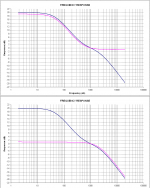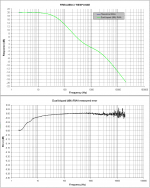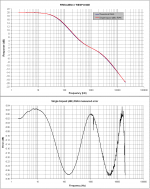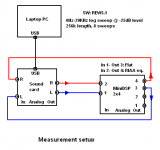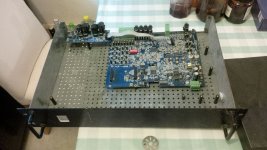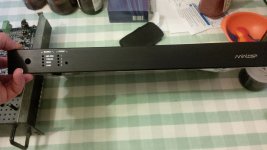Keith Johnson showed me a VW microbus that did the same thing 25 years ago. We all thought they were a hoot. Cost around $30 then. Way pre Bluetooth.
Sent from my LG-H811 using Tapatalk
Sent from my LG-H811 using Tapatalk
Just for fun, why not ?.....
Yeah I've heard about them, nasty but fun just like those thin flexible transparent 45's that came with magazines, newspapers, corn flakes etc.
BTW what happened to those little clip together toys that were buried down the bottom of the cereal box....taught me things like visualising assembly of parts and even Newtonian physics.
soundwagon-record-player
SOUNDWAGON Instructional Video
2015 update - the-soundwagon-is-dead-long-live-record-runner
Ok, back to the subject at hand, interesting as always around here.
Dan.
Yeah I've heard about them, nasty but fun just like those thin flexible transparent 45's that came with magazines, newspapers, corn flakes etc.
BTW what happened to those little clip together toys that were buried down the bottom of the cereal box....taught me things like visualising assembly of parts and even Newtonian physics.
soundwagon-record-player
SOUNDWAGON Instructional Video
2015 update - the-soundwagon-is-dead-long-live-record-runner
So, in hipster heaven old is new again, the difference is hipster cool laser cut bamboo enclosure, Bluetooth and the claim that 'fine balancing' reduces record wear, ya just get the crowd to stump up the development costs for an essentially useless toy....woteva.For those not in the know, the Record Runner is a battery-powered record player. You place vinyl on a flat surface, and the Record Runner spins on the vinyl, and pushes sound out through the frankly awful speaker. It’s not perfect, but it’s not designed to be. It’s fun, and that’s what you’re paying for.
I have an idea for Stokyo — do a version with Bluetooth. This will let it push the audio out through little speakers (ideal for bedrooms) or headphones (ideal for digging). Sure, it’ll go through a shedload of batteries, but it’ll be a valuable addition and bring it bang up to date. Anyway, welcome back little VW spinny record player. We missed you.
Ok, back to the subject at hand, interesting as always around here.
Dan.
Last edited:
Needle, cheapest phono cart you could find, the stylus is the 'steering wheel' as per the video I posted.Needle or optical reading?
George
Audiophile versions/upgrades ? lol.
Dan.
Last edited:
I can remember as a kid, many years ago, recording onto one of those vinyl discs. I formed a small paper horn and stuck a needle through the end and spoke or shouted into the horn like Edison while holding it onto the spinning vinyl. Replay just required sliding the needle into the groove.Yeah I've heard about them, nasty but fun just like those thin flexible transparent 45's that came with magazines, newspapers, corn flakes etc.
Dan.
Then Jan is anoise maker 😛
George
Hah! I've been called much worse names! 😎
Also did you try the dual bi-quad at 48K which should be almost perfect?
Yes finally.
Here are my measurements at the output of my 2x4MiniDSP.
First attachment: The freq response rel 1KHz from the two biquads in isolation (in blue the theoretical RIAA curve)
1st biquad (48KHz) coefficients:
-13.73dB (RIAA)
poles = [2112.13558715, 33306.8973142]
zeros = [17945.9351038, 41551.3073517]
a coefficients = [ a0=1 a1= 0.3860447 a2=0.28092631]
b coefficients = [ b0=1 b1=0. 54257034 b2=0.03711006]
Gain at 1kHz = 12.6531891507 dB
2nd biquad (48KHz) coefficients:
50.05 Hz and 500.5 Hz (RIAA)
poles = [27000.4683709, 50.0497911677]
zeros = [27003.1704285, 500.320253393]
a coefficients = [ a0=1 a1=0.71622826 a2=0.27543121]
b coefficients = [ b0=1 b1=-0.659297 b2=-0.25970356]
Gain at 1kHz = 0.705745669113 dB
Second attachment: The freq response rel. 1KHz of the resulting dual biquad (48k) RIAA (the two above biquads cascaded) and the error.
Third attachment (for comparison): The freq response rel. 1KHz of the single biquad (48k) RIAA and the error.
Single biquad RIAA (48KHz) coefficients:
poles = [52.5257285337, 2287.22026941]
zeros=[21833.6972506, 536.805364274]
a coefficients = [ a0=1 a1=1.73273489 a2=-0.73451925]
b coefficients = [ b0=1 b1=-0.75549731 b2=-0.16463057]
Gain at 1kHz = 13.16179286 dB
Forth attachment: The phase response of the two (single and dual biquad) RIAA implementations.
Fifth attachment: Measurement setup (*)
Errors of both -all digital- RIAA implementations are within the limits that Scott has mentioned in his LA vol. 10 article.
The dual biquad RIAA having ridiculously small error wins the competition.
All the coefficients shown above, have been copied from Jan’s site download section with no other change except from the sign reversal of the ‘a’ coefficients.
https://linearaudio.net/sites/linearaudio.net/files/v10 sw app1 table a-1.xlsx
https://linearaudio.net/sites/linearaudio.net/files/v10 sw Appendix 1b web.docx
Once again, thanks to Scott for all the work and to Jan for publishing and hosting it.
(*) The description of how I performed these measurements is to be found in post # 294. The procedure is exactly the same, I only have lowered the resolution (652 data points per measurement)
George
Attachments
Yes finally.
Here are my measurements at the output of my 2x4MiniDSP.
Once again, thanks to Scott for all the work and to Jan for publishing and hosting it.
(*) The description of how I performed these measurements is to be found in post # 294. The procedure is exactly the same, I only have lowered the resolution (652 data points per measurement)
George
The residual low rolloff is probably the AC coupling on the miniDSP.

Yes, the insignificant drop (-0.09dB at 20Hz, -0.016dB at 10Hz, -0.037dB at 5Hz) most probably is due to the imbalance btn the hardware of the two channels of the measurement setup chain (soundcard+2x4MiniDSP).
The results shown are R channel (RIAA eq) minus L channel (flat) because the intent of the exercise was to test the performance of the algorithms and the DSP part of the 2x4MiniDSP only.
This means that the hardware constrains common to both channels like low freq and high freq roll off don’t show up except when there is some small difference btn the hardware of the two channels.
In actual use, the operation will not be R channel minus L channel, therefore the frequency roll-off due to hardware will be as expected more pronounced:
2x4MiniDSP:-0.27dB at 20Hz, -0.56dB at 10Hz, -2.38dB at 5Hz)
Soundcard: -0.21dB at 20Hz, -0.48dB at 10Hz, -2.11dB at 5Hz)
Attachment: Testing 2x4 MiniDSP.
Gain structure is THE important point which may affect MiniDSP 'sonics'.
From post 24 and on:
http://www.diyaudio.com/forums/minidsp/230470-signal-level-minidsp-x-over-3.html#post3412698
George
The results shown are R channel (RIAA eq) minus L channel (flat) because the intent of the exercise was to test the performance of the algorithms and the DSP part of the 2x4MiniDSP only.
This means that the hardware constrains common to both channels like low freq and high freq roll off don’t show up except when there is some small difference btn the hardware of the two channels.
In actual use, the operation will not be R channel minus L channel, therefore the frequency roll-off due to hardware will be as expected more pronounced:
2x4MiniDSP:-0.27dB at 20Hz, -0.56dB at 10Hz, -2.38dB at 5Hz)
Soundcard: -0.21dB at 20Hz, -0.48dB at 10Hz, -2.11dB at 5Hz)
One last point, the miniDSP as some have found is on the edge in some applications and the gain structure of the whole signal path must be looked at carefully.
Attachment: Testing 2x4 MiniDSP.
Gain structure is THE important point which may affect MiniDSP 'sonics'.
From post 24 and on:
http://www.diyaudio.com/forums/minidsp/230470-signal-level-minidsp-x-over-3.html#post3412698
Some wrap-up here.
The MiniDSP Input attenuation slider is implemented in the digital domain, past the input, after the A/D conversion. So, when a signal applied at the input has an amplitude greater than the clipping threshold level, it overdrives (clips) the A/D converter.
Adjusting the input attenuator to a lower click, will not attenuate the analog input signal and will not prohibit the A/D clipping. It will attenuate the digital clipped signal which will be further processed and furnished to the outputs in it’s clipped form.
If the signal applied to the input has a high amplitude but still below clipping level, it may clip during processing if excess boosting is applied through filters.
E.g. A signal 6db below the clipping level is applied to the input.
Then If a filter is added with a gain of anything more than 6db -or a succession of filters with total boosting greater than 6db at a certain frequency- the digital signal will “clip”. This will manifest itself at the Output meter which will read “0”.
This clipping due to filter “overboosting” can be canceled by applying attenuation through the output slider. The amount of attenuation in db has to be equal to the excess gain applied by the filters.
This trick has a limit. This limit is 24db. If the excess gain is more than 24 db, the output attenuators are not able to render signal undistorted. In this case the output signal will not look clipped but bent and skewed, looking like a slew limited signal.
http://www.diyaudio.com/forums/analogue-source/attac...1&d=1361568128
Strange behavior indeed. But this made me look at the ADAU1701 data sheet http://www.analog.com/static/importe...s/ADAU1701.pdf which verified this 24db overhead.
Now things became clear to me. The internal flow is as follows.
1. Analogue signal entry.
2. A/D converter.
3. Input attenuator and Input RMS meter.
4. Pre-filter bank.
5. X-over filter bank.
6. Post-filter bank.
7. Output attenuator and Output meter.
8. D/A converter.
9. Reconstruction filter.
10. Analogue signal exit.
Everything between A/D converter output and D/A converter Input (digital domain) gets an +24db max overhead, while the A/D and D/A operate on 0db max level. The plug-in RMS meters monitor each A/D digital output and each D/A digital input respectively
George
Attachments
George, you really have done all the homework to make it easier for the rest of us.Thank you I am embarassed to admit my miniDSP has been gathering dust for 2 years now. Mainly because i made the false economy of not spending $130 on the official case for it and thinking I could mod something I already had, whilst dealing with a full time job and 5 kids. That was dumb of me.
Mainly because i made the false economy of not spending $130 on the official case for it and thinking I could mod something I already had,
Bill
Beauty is in the eyes of the beholder of course but if you manage to surpass me in housing ugliness and shamelessly turn a temporary test set into the main element of a more or less continuously evolving audio 'system' (my excuse: life is short), I’ll eat my hat 😀
http://www.diyaudio.com/forums/minidsp/238892-my-stack.html#post3554127
George
That actually looks rather neat (to me). I meant there are knobs and labels. My current pre-amp has one so I can remember which is volume. I'll try and and remember to take a picture. Sadly no evidence left of the OTL amp a friend and I build on a piece of wood, or the tube PSU in a cardboard box. Silly me, we all know baking trays are best for prototypes 🙂.
Well ordered the proper 2x8 box last night so lets see where we go. Looking at your stack I think I see a ministreamer in my future. I've worked out most of the setup I need, the only annoyance is will still need an analog signal routing setup to switch between vinyl and the home theatre.
Right back to kitchen. Wife is not feeling well (for once ACTUALLY my fault) so all inedible food tomorrow I can take the blame for 🙂.
Well ordered the proper 2x8 box last night so lets see where we go. Looking at your stack I think I see a ministreamer in my future. I've worked out most of the setup I need, the only annoyance is will still need an analog signal routing setup to switch between vinyl and the home theatre.
Right back to kitchen. Wife is not feeling well (for once ACTUALLY my fault) so all inedible food tomorrow I can take the blame for 🙂.
Whilst still debating how to fit the kenwood into the listening area I am still mulling about how to do the amplification. So many things to consider. Now as I think I have previously mentioned I think the Bob Cordell method of loading down the cartridge to provide at least some of the HF roll-off has a certain charm. Looking through the LA archives I discovered that Bob is not the first to examine this in the magazine and in fact Steven van Raalte did an article in volume 3 which went a step further and introduced an 'inverse resonance filter' to deal with the mechanical resonance that is put into most MM cartridges to lift the high end. Now whilst Grado owners can be smug at this point, the filter Steven looks at is an analog biquad so is a perfect candidate for implementing in MiniDSP. What I haven't got my head fully around is the noise penalty Bob talks about with using the damped method to implement the full 75uS equalisation. Ideal would be to have a cartridge that doesn't use these helper resonances (again stop being smug Grado owners) but getting to that is a seperate discussion for another thread which I am working on...
Enough stuff in here to blow your mind, well mine anyway !
Includes free App's to DL
Digital Phono Equalization
Introduction
Some may want to equalize their vinyl digitally for some reason. For one, some modern preamps are all digital, requiring digital equalization. Others, wanting to record their LPs to their computer, attribute some benefit to equalizing their collection without the sonic defects attributed to circuits with analog capacitors. I attempt here to address the latter interest mainly, although it has application to the former as well.
Website of Wayne Stegall - Phono Equalization Calculations
Includes free App's to DL
Looking at his book, he is more than a little paranoid.
Maybe not ! Anyway, if someone has valuable tech contributions to make, what's the problem ? None as far as i'm concerned 😉
It was just a bit of a shock when I clicked home to get to the digital RIAA article. The combination of dry tech articles, his claims in his resume of the book and the comment on capacitor sound make me happy to read his articles, but not to want to be sat next to him on an aeroplane!
- Status
- Not open for further replies.
- Home
- Source & Line
- Analogue Source
- Digitizing vinyl
